Police versus Prisons
Here’s a remarkable graph from the Council of Economic Advisers report on incarceration and the criminal justice system. The graph shows that the United States employs many more prison guards per-capita than does the rest of the world. Given our prison population that isn’t surprising. What is surprising is that on a per-capita basis we employ 35% fewer police than the world average. That’s crazy.

Our focus on prisons over police may be crazy but it is consistent with what I called Gary Becker’s Greatest Mistake, the idea that an optimal punishment system combines a low probability of being punished with a harsh punishment if caught. That theory runs counter to what I have called the good parenting theory of punishment in which optimal punishments are quick, clear, and consistent and because of that, need not be harsh.
We need to change what it means to be “tough on crime.” Instead of longer sentences let’s make “tough on crime” mean increasing the probability of capture for those who commit crimes.
Increasing the number of police on the street, for example, would increase capture rates and deter crime and by doing so it would also reduce the prison population. Indeed, in a survey of crime and policing that Jon Klick and I wrote in 2010 we found that a cost-benefit analysis would justify doubling the number of police on the street. We based our calculation not only on our own research from Washington DC but also on the research of many other economists which together provide a remarkably consistent estimate that a 10% increase in policing would reduce crime by 3 to 5%. Using our estimates, as well as those of some more recent papers, the Council of Economic Advisers also estimates big benefits (somewhat larger than ours) from an increase in policing. Moreover, what the CEA makes clear is that a dollar spent on policing is more effective at reducing crime than a dollar spent on imprisoning.
Unfortunately, selling the public on more policing is likely to be difficult. Some of the communities most in need of more police are also communities with some of the worst policing problems. We aren’t likely to get more policing until people are convinced that we have better policing. Moreover, people are right to be skeptical because the type of policing that works is not simply boots on the ground. As the CEA report notes:
Model policing tactics are marked by trust, transparency, and collaborations between police and community stakeholders…
Better policing and more policing complement one another. Greater trust can come with body cameras as well as community oversight and other efforts to bring transparency and accountability. Most importantly, the drug war has eroded trust between police and community and that has led to an endogenous equilibrium in which some communities are rife with both drugs and crime. Fortunately, marijuana decriminalization and legalization have begun to move resources away from the war on drugs. Legalization in states like Colorado does not appear to have increased crime and has likely contributed to a dramatic decline of violence in Mexico. As we move resources away from drug crime, police will have more resources to raise the punishment rate for those traditional crimes like murder, robbery and rape that communities everywhere do want punished.
Addendum: See also Peter Orszag’s column on this issue.